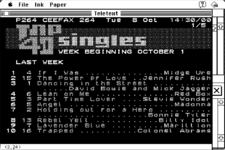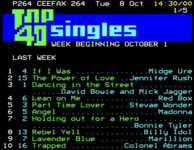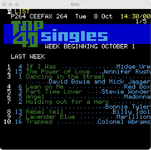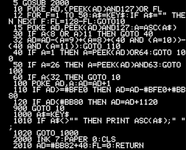Snial
Well-known member
Teletext was a TV magazine system, popular across Europe, but originating in the UK. It sequenced through hundreds of pages of text stored in the vertical blanking scans of a PAL or SECAM image; things like news; TV guides; weather; cooking. It could also generate closed-captioning, i.e. subtitles.
In honour of the 50th anniversary (yep, it first went live in late 1974, see this video), for fun I wrote a Teletext renderer/editor for a classic monochrome Mac. It's only 8kB, and I've done some basic testing on a Mac 128K via Infinite Mac, which is the basic point, what would Teletext have been like on the original hardware?
The real challenge is mapping Teletext colours to 1bpp. My approach is to create a 12x12 font containing a chunky character set + block graphics so that colours can be mapped to different shades and masked to the foregrounds and backgrounds. I chose the Top40 singles screenshot again as an example! You can see the difference between white, yellow, green and cyan text; green and cyan block graphics against black or blue backgrounds.
Version 0.11 is pretty rough. Quite a lot of characters are uglier than they could be. It doesn't model serial attributes, they're all parallel, so it can create impossible Teletext pictures. It doesn't support flash. It can't save or load Teletext screens. Finally, because of all the masking; characters are drawn as slowly as a ZX81 in SLOW mode
 !
!
Nevertheless, as a first attempt at generating a Ceefax page I'm very pleased, as it's readable! It's currently running in miniVMac, but in theory, it could be massively enhanced by adding a Serial-baed Teletext decoder.
Here's my first Teletext picture I've created:

It's based on a real Ceefax (the BBC's Teletext transmissions) from, I think 1985. This is how it looked on a TV:

ThinkC project and Application for System 7 or System 2 (which works on a Mac128K) is attached.
In honour of the 50th anniversary (yep, it first went live in late 1974, see this video), for fun I wrote a Teletext renderer/editor for a classic monochrome Mac. It's only 8kB, and I've done some basic testing on a Mac 128K via Infinite Mac, which is the basic point, what would Teletext have been like on the original hardware?
The real challenge is mapping Teletext colours to 1bpp. My approach is to create a 12x12 font containing a chunky character set + block graphics so that colours can be mapped to different shades and masked to the foregrounds and backgrounds. I chose the Top40 singles screenshot again as an example! You can see the difference between white, yellow, green and cyan text; green and cyan block graphics against black or blue backgrounds.
Version 0.11 is pretty rough. Quite a lot of characters are uglier than they could be. It doesn't model serial attributes, they're all parallel, so it can create impossible Teletext pictures. It doesn't support flash. It can't save or load Teletext screens. Finally, because of all the masking; characters are drawn as slowly as a ZX81 in SLOW mode

Nevertheless, as a first attempt at generating a Ceefax page I'm very pleased, as it's readable! It's currently running in miniVMac, but in theory, it could be massively enhanced by adding a Serial-baed Teletext decoder.
Here's my first Teletext picture I've created:

It's based on a real Ceefax (the BBC's Teletext transmissions) from, I think 1985. This is how it looked on a TV:

ThinkC project and Application for System 7 or System 2 (which works on a Mac128K) is attached.



